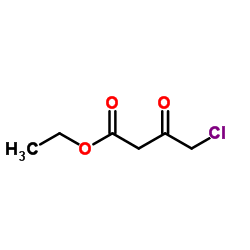Ethyl 2-Chloroacetoacetate

Ethyl 2-Chloroacetoacetate structure
|
Common Name | Ethyl 2-Chloroacetoacetate | ||
|---|---|---|---|---|
| CAS Number | 638-07-3 | Molecular Weight | 164.587 | |
| Density | 1.2±0.1 g/cm3 | Boiling Point | 235.5±0.0 °C at 760 mmHg | |
| Molecular Formula | C6H9ClO3 | Melting Point | -8 °C | |
| MSDS | Chinese USA | Flash Point | 96.7±0.0 °C | |
| Symbol |


GHS05, GHS06 |
Signal Word | Danger | |
|
Construction of a two-strain system for asymmetric reduction of ethyl 4-chloro-3-oxobutanoate to (S)-4-chloro-3-hydroxybutanoate ethyl ester.
Appl. Microbiol. Biotechnol. 70(1) , 40-6, (2006) Escherichia coli M15 (pQE30-car0210) was constructed to express carbonyl reductase (CAR) by cloning the car gene from Candida magnoliae and inserting it into pQE30. By cultivating E. coli M15 (pQE30-car0210) and M15 (pQE30-gdh0310), 8.2-fold and 12.3-fold enh... |
|
|
Purification and characterization of an alpha-haloketone-resistant formate dehydrogenase from Thiobacillus sp. strain KNK65MA, and cloning of the gene.
Biosci. Biotechnol. Biochem. 67(10) , 2145-53, (2003) Thiobacillus sp. strain KNK65MA, which produced an NAD-dependent formate dehydrogenase (FDH) highly resistant to alpha-haloketones, was newly isolated, i.e., the enzyme showed no loss of activity after a 5-h incubation with alpha-haloketones, such as ethyl 4-... |
|
|
A novel carbonyl reductase from Pichia stipitis for the production of ethyl (S)-4-chloro-3-hydroxybutanoate.
Biotechnol. Lett. 31(4) , 537-42, (2009) An NADPH-dependent carbonyl reductase (PsCR) gene from Pichia stipitis was cloned. It contains an open reading frame of 849 bp encoding 283 amino acids whose sequence had less than 60% identity to known reductases that produce ethyl (S)-4-chloro-3-hydroxybuta... |
|
|
Biosimulation of drug metabolism—A yeast based model
Eur. J. Pharm. Sci. 36(1) , 157-70, (2009) Computationally predicting the metabolic fates of drugs is a very complex task which is owed not only to the huge and diverse biochemical network in the living cell, but also to the majority of in vivo transformations that occur through the action of hepatocy... |
|
|
Enantioselective bioconversion using Escherichia coli cells expressing Saccharomyces cerevisiae reductase and Bacillus subtilis glucose dehydrogenase.
J. Microbiol. Biotechnol. 20(9) , 1300-6, (2010) Ethyl (R, S)-4-chloro-3-hydroxybutanoate (ECHB) is a useful chiral building block for the synthesis of L-carnitine and hypercholesterolemia drugs. The yeast reductase, YOL151W (GenBank locus tag), exhibits an enantioselective reduction activity, converting et... |
|
|
A novel reductase from Candida albicans for the production of ethyl (S)-4-chloro-3-hydroxybutanoate.
Biosci. Biotechnol. Biochem. 76(6) , 1210-2, (2012) A novel NADPH-dependent reductase (CaCR) from Candida albicans was cloned for the first time. It catalyzed asymmetric reduction to produce ethyl (S)-4-chloro-3-hydroxybutanoate ((S)-CHBE). It contained an open reading frame of 843 bp encoding 281 amino acids.... |
|
|
Development of a substrate-coupled biocatalytic process driven by an NADPH-dependent sorbose reductase from Candida albicans for the asymmetric reduction of ethyl 4-chloro-3-oxobutanoate.
Biotechnol. Lett. 34(12) , 2223-7, (2012) A substrate-coupled biocatalytic process was developed based on the reactions catalyzed by an NADPH-dependent sorbose reductase (SOU1) from Candida albicans in which ethyl 4-chloro-3-oxobutanoate (COBE) was reduced to (S)-4-chloro-3-hydroxybutanoate [(S)-CHBE... |
|
|
Purification and properties of a carbonyl reductase involved in stereoselective reduction of ethyl 4-chloro-3-oxobutanoate from Cylindrocarpon sclerotigenum IFO 31855.
Biosci. Biotechnol. Biochem. 67(6) , 1417-20, (2003) A NADPH-dependent carbonyl reductase (CSCR1) was purified to homogeneity from Cylindrocarpon sclerotigenum IFO 31855. The enzyme catalyzed the stereoselective reduction of ethyl 4-chloro-3-oxobutanoate to the corresponding (S)-alcohol with a >99% enantiomer e... |
|
|
Asymmetric reduction of ethyl 4-chloro-3-oxobutanoate to ethyl (R)-4-chloro-3-hydroxybutanoate with two co-existing, recombinant Escherichia coli strains.
Biotechnol. Lett. 27(2) , 119-25, (2005) Two recombinant strains, E. coli M15 (pQE30-alr0307) and E. coli M15 (pQE30-gdh0310), which were constructed to express, respectively, an NADPH-dependent aldehyde reductase gene and a glucose dehydrogenase gene, were mixed in an appropriate ratio and used for... |
|
|
Efficient production of recombinant aldehyde reductase and its application for asymmetric reduction of ethyl 4-chloro-3-oxobutanoate to ethyl (R)-4-chloro-3-hydroxybutanoate.
Prep Biochem Biotechnol. 35(3) , 203-15, (2005) An NADPH-dependent aldehyde reductase (ALR, EC1.1.1.2) gene is cloned from Sporobolomyces salmonicolor ZJUB 105, and inserted into plasmid pQE30 to construct the expression plasmid (pQE30-ALR). A variety of E. coli strains were employed as hosts to obtain tra... |